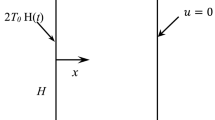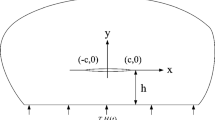This paper studies the transient thermal fracture problem of a semi-infinite medium containing an edge crack using the non-Fourier heat conduction theory. Dual-phase-lag (DPL) model, which takes into account the effect of higher-order terms, (named x-DPL model) is proposed to predict the temperature gradient of the medium, which experiences a heat shock on its edge. The temperature gradient and the corresponding thermal stresses are obtained by applying the Laplace transform method and neglecting the thermo-elastic coupling and inertial effects in the absence of crack for the semi-infinite medium. Thereafter, mode I crack problem is formulated in the Laplace domain using the superposition method. Numerical results of the thermal stress and mode I stress intensity factor (SIF) are calculated by implementing Durbin’s method in the time domain. The effects of higher-order terms on the axial thermal stress and the mode I SIF are investigated and discussed. The DPL model that considers higher-order terms is more conservative than this model neglecting these terms.

















Similar content being viewed by others
References
P. P. Krasnyuk, “Thermoelastic contact problem for a layer interacting with a rigid substrate under transient frictional heat generation conditions,” Strength Mater., 40, No. 3, 381–395 (2008), https://doi.org/https://doi.org/10.1007/s11223-008-9024-0.
P. Vernotte, “Les paradoxes de la theorie continue de l’equation de la chaleur,” Compt. Rendu, 246, 3154–3155 (1958).
D. Y. Tzou, “The generalized lagging response in small-scale and high-rate heating,” Int. J. Heat Mass Tran., 38, No. 17, 3231–3240 (1995).
K. Daneshjou, M. Bakhtiari, H. Parsania, and M. Fakoor, “Non-Fourier heat conduction analysis of infinite 2D orthotropic FG hollow cylinders subjected to time-dependent heat source,” Appl. Therm. Eng., 98, 582–590 (2016).
K. Daneshjou, M. Bakhtiari, R. Alibakhshi, and M. Fakoor, “Transient thermal analysis in 2D orthotropic FG hollow cylinder with heat source,” Int. J. Heat Mass Tran., 89, 977–984 (2015).
M. Bakhtiari, K. Daneshjou, H. Parsania, and M. Fakoor, “Hyperbolic heat conduction analysis for an orthotropic FG hollow sphere with internal heat source. Application of a new augmented state space method,” Heat Transf. Res., 48, No. 15, 1399–1419 (2017).
A. S. Semenov and L. B. Getsov, “Thermal fatigue fracture criteria of single crystal heat-resistant alloys and methods for identification of their parameters,” Strength Mater., 46, No. 1, 38–48 (2014), https://doi.org/https://doi.org/10.1007/s11223-014-9513-2.
V. D. Poznyakov, L. I. Markashova, V. D. Shelyagin, et al., “Cold cracking resistance of butt joints in high-strength steels with different welding techniques,” Strength Mater., 51, No. 6, 843–851 (2019), https://doi.org/https://doi.org/10.1007/s11223-020-00132-7.
V. M. Finkel’ and N. I. Alyushina, “Mechanisms of crack initiation and fracture of the surface of crystals of lithium fluoride and calcite in pulsed thermal loading,” Strength Mater., 17, No. 3, 355–360 (1985), https://doi.org/https://doi.org/10.1007/BF01755921.
G. N. Tret’yachenko and B. S. Karpinos, “Mechanical and thermophysical characteristics of materials in fracture,” Strength Mater., 21, No. 9, 1146–1152 (1989), https://doi.org/https://doi.org/10.1007/BF01529287.
H. Nied and F. Erdogan, “Transient thermal stress problem for a circumferentially cracked hollow cylinder,” J. Therm. Stresses, 6, No. 1, 1–14 (1983).
K. Jayadevan, “Critical stress intensity factors for cracked hollow pipes under transient thermal loads,” J. Therm. Stresses, 25, No. 10, 951–968 (2002).
R. Ghajar and S. Nabavi, “Closed-form thermal stress intensity factors for an internal circumferential crack in a thick-walled cylinder,” Fatigue Fract. Eng. Mater. Struct., 33, No. 8, 504–512 (2010).
H. Nied, “Thermal shock in an edge-cracked plate subjected to uniform surface heating,” Eng. Fract. Mech., 26, No. 2, 239–246 (1987).
S. L. Guo, B. L. Wang, and J. E. Li, “Surface thermal shock fracture and thermal crack growth behavior of thin plates based on dual-phase-lag heat conduction,” Theor. Appl. Fract. Mech., 96, 105–113 (2018).
N. Naotake and A. Fumihiro, “Thermal shock in a transversely isotropic cylinder containing an annular crack,” Int. J. Solids Struct., 30, No. 3, 427–440 (1993).
D. M. Chang, X. F. Liu, B. L. Wang, et al., “Non-Fourier thermal shock fracture of solids with shallow semi-elliptical surface crack,” Theor. Appl. Fract. Mech., 96, 160–167 (2018).
N. Noda and F. Ashida, “Stress intensity factor for transient thermal stresses in a transversely isotropic infinite body with an external circular crack,” Acta Mech., 66, No. 1, 217–231 (1987).
L. M. Chen, J. W. Fu, and L. F. Qian, “On the non-Fourier thermal fracture of an edge-cracked cylindrical bar,” Theor. Appl. Fract. Mech., 80, 218–225 (2015).
H. Jia and Y. Nie, “Thermoelastic analysis of multiple defects with the extended finite element method,” Acta Mech. Sin., 32, No. 6, 1123–1137 (2016).
N. Soltani, M. Alembagheri, and M. H. Khaneghahi, “Risk-based probabilistic thermal-stress analysis of concrete arch dams,” Front. Struct. Civ. Eng., 13, No. 5, 1007–1019 (2019).
J. Fu, Z. Chen, L. Qian, and Y. Xu, “Non-Fourier thermoelastic behavior of a hollow cylinder with an embedded or edge circumferential crack,” Eng. Fract. Mech., 128, 103–120 (2014).
J. Fu, Z. Chen, L. Qian, and K. Hu, “Transient thermoelastic analysis of a solid cylinder containing a circumferential crack using the C–V heat conduction model,” J. Therm. Stresses, 37, No. 11, 1324–1345 (2014).
D. Y. Tzou, “Three dimensional structures of the thermal shock waves around a rapidly moving heat source,” Int. J. Eng. Sci., 28, No. 10, 1003–1017 (1990).
J. J. Mason and A. J. Rosakis, “On the dependence of the dynamic crack tip temperature fields in metals upon crack tip velocity and material parameters,” Mech. Mater., 16, No. 4, 337–350 (1993).
J. J. Mason and A. J. Rosakis, “The effects of hyperbolic heat conduction around a dynamically propagating crack tip,” Mech. Mater., 15, No. 4, 263–278 (1993).
A. Amani Dashlejeh, “Isogeometric analysis of coupled thermo-elastodynamic problems under cyclic thermal shock,” Front. Struct. Civ. Eng., 13, No. 2, 397–405 (2019).
D. Chang and B. Wang, “Transient thermal fracture and crack growth behavior in brittle media based on non-Fourier heat conduction,” Eng. Fract. Mech., 94, 29–36 (2012).
B. Wang and J. Han, “Fracture mechanics associated with non-classical heat conduction in thermoelastic media,” Sci. China Phys. Mech. Astron., 55, No. 3, 493–504 (2012).
B. L. Wang, “Transient thermal cracking associated with non-classical heat conduction in cylindrical coordinate system,” Acta Mech. Sin., 29, No. 2, 211–218 (2013).
Author information
Authors and Affiliations
Corresponding author
Additional information
Translated from Problemy Mitsnosti, No. 3, p. 118, May – June, 2022.
Rights and permissions
Springer Nature or its licensor holds exclusive rights to this article under a publishing agreement with the author(s) or other rightsholder(s); author self-archiving of the accepted manuscript version of this article is solely governed by the terms of such publishing agreement and applicable law.
About this article
Cite this article
Fakoor, M., Sotoudeh, S. Effect of Higher-Order Terms in the Thermal Transient Stress Intensity Factor for a Cracked Semi-Infinite Medium Under Thermal Shock. Strength Mater 54, 525–535 (2022). https://doi.org/10.1007/s11223-022-00427-x
Received:
Published:
Issue Date:
DOI: https://doi.org/10.1007/s11223-022-00427-x




